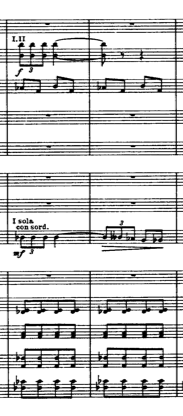Now, to look at some rhythms. It was the rhythmic aspect of the Rite that struck the listeners most of all at the premiere and the first performances in various venues. The critic for the London Times commented on the first performances there in July 1913 that Stravinsky had sacrificed melody and harmony for rhythm. This is not at all true, of course. The Rite is full of remarkably folk-like melodies, some of which have a Lithuanian origin, others Russian. There is also a lot of very nice harmony, not so terribly different from the sort of harmony that Debussy was using. But the rhythmic element has been brought forward and placed at least on a par with melody and harmony and this is something quite new to ballet--at least since the Baroque ballets which were based on country dances elaborated for the nobility. Throughout the 19th century there was a steady weakening of the pure rhythmic element in ballet. You could certainly argue that Stravinsky brought back the rustic rhythmic qualities of the dance and gave it a pagan twist by the use of montage. More about this later. But first, a little selection of Baroque dances in the French style:
That is just for a little background. During the 19th century, the rhythmic element faded a bit in favor of melody. Here is a sample of the kind of dancing that it accompanied:
It is very beautiful and athletically demanding of the dancers, but what it is not is rhythmic in a rustic or primitivistic way. That was what Stravinsky was going to add. Here is the section "Augers of Spring" from part one. It is usually played a little more vigorously than this, but this is the only clip I could find that has just this section:
And here is the score of the beginning of this part:
What is going on here is fairly simple. The strings are laying down a very solid repetitive beat (on a D flat harmony in first inversion) while over top the horns bark out chords on the offbeat (sounding as E flat and F flat chords). The offbeat chords are followed by ones on the beat. Simple, but very effective. A lot of the strength of Stravinsky's writing in these early ballets comes from his genius in orchestration--he did study with Rimsky-Korsakov after all! A bit later he adds another level by overlaying this simple texture with triplets in the oboe and trumpet:
All this develops into a much more complex texture, but still with that underlying pulse. Here is a bit later on. The strings are still laying down the beat, but some of the violins are subdividing it in sixteenths while others are trilling. The horns (marked mais en dehors) are playing one of those folk-like melodies:
In the "Ritual of Abduction" we can see some of what has been called "montage" or "cubist" rhythmic treatment. This consists of juxtaposing different meters in close proximity, as Eisenstein, the Soviet filmmaker juxtaposed different scenes, cutting abruptly from one to the other. Wikipedia has a good article on this technique. Bear in mind that Eisenstein's book on montage was not written until 1923, a decade after the Rite. What we see in the example below is hard to classify in terms of montage theory in film, but let's call it "metric" montage because that would be the correct term in music. We know from the previous page that this page starts with a measure of 3/4. This is followed by a measure of 6/8--the same number of eighth notes, but grouped differently: two groups of three instead of three groups of two. Spanish music has been using this kind of metric contrast for a long time. But Stravinsky is just getting started. Next we have a measure of 2/8, like a single beat forcefully inserted to jolt the listener. Then back to 6/8. It is important to preserve the contrast by returning frequently to the basic meter. Then another interjection, but this time two chords. Then back to the 6/8. The effect of this kind of montage is to create tension or conflict. As Wikipedia says, "Eisenstein's montage theories are based on the idea that montage originates in the "collision" between different shots in an illustration of the idea of thesis and antithesis."
I think I will stop there for today and return to the subject in another post. Let's end with another version of the Rite. Here is part one conducted by Hans Swarowsky with the Süddeutsche Philharmonie:





No comments:
Post a Comment